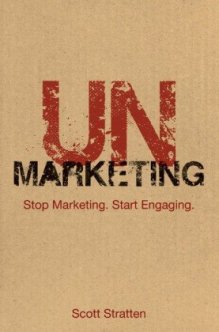 When marketing consultant Scott Stratten worked with the owners of a new restaurant, he recommended inviting residents of a nearby condo complex to a free dinner. Over two nights, the owners could get 150 people to start the buzz about the new restaurant in town.
When marketing consultant Scott Stratten worked with the owners of a new restaurant, he recommended inviting residents of a nearby condo complex to a free dinner. Over two nights, the owners could get 150 people to start the buzz about the new restaurant in town.
But the owners balked at giving away free food, which they estimated would cost them several thousand dollars. Yet they had spent $5,000 on a magazine ad!
“How many customers did it bring in?” Stratten asked. “We don’t know,” they replied.
Does this sound familiar? Stratten calls this the “push and pray” marketing strategy. You push your ad out to thousands and even millions of people, and pray that some respond.
 “The food cost and my fee would have been less than the amount they paid for that ad,” Stratten writes in his book, UnMarketing: Stop Marketing. Start Engaging. And in just two days, the restaurant owners potentially would have created 150 satisfied customers to spread the word about their restaurant.
“The food cost and my fee would have been less than the amount they paid for that ad,” Stratten writes in his book, UnMarketing: Stop Marketing. Start Engaging. And in just two days, the restaurant owners potentially would have created 150 satisfied customers to spread the word about their restaurant.
But the owners just didn’t get it. They refused to implement the strategy, and eventually they went out of business.
Stratten believes business is about creating and managing relationships with current and potential customers. Find people who are already talking about you, engage them and give them something of value. He calls this marketing strategy “pull and stay.” Pull potential customers to your business by engaging them, trade something they value for their name and contact information and stay in touch with them.
“If you believe business is built on relationships,” Stratten writes, “make building them your business. UnMarketing is all about engagement at every point of contact with your market.”
Use Social Media to Enter the Conversation
Stratten believes social media is the best way to find and engage potential customers. “If I told you that I had a room full of current potential customers all talking about your products and your competitors, would you not show up?”
If you’ve read our articles, you already know how to do this. Download TweetDeck and set one of the columns to monitor tweets containing keywords related to your business or your company name. When you see such a tweet, respond. Try to provide value in every tweet.
A self-described Twitter fanatic, Stratten decided in March 2009 to ask his 16,000 Twitter followers to help him raise money for a charity that focuses on child hunger. Together they raised $12,000 in just 5.5 hours.
Facebook and LinkedIn are permission-based, but there’s no barrier to communicating with anyone on Twitter. So he recommends starting on Twitter and using Facebook and LinkedIn to “go to the next level.”
He even uses Twitter to find out more about local businesspeople before he goes to a networking event.
This book essentially contains 55 ideas for “unmarketing” your business. Each chapter is one idea. And they’re in no particular order. So you can read the chapters in whatever order you want.
Get World-Class Marketing Training — All Year Long!
Are you facing doubt, uncertainty, or overwhelm? The Social Media Marketing Society can help.
Each month, you’ll receive training from trusted marketing experts, covering everything from AI to organic social marketing. When you join, you’ll also get immediate access to:
- A library of 100+ marketing trainings
- A community of like-minded marketers
- Monthly online community meetups
- Relevant news and trends updates

Discover Proven Marketing Strategies and Tips
Want to go even deeper with your marketing? Check out the Social Media Marketing Podcast! Publishing weekly since 2012, the Social Media Marketing Podcast helps you navigate the constantly changing marketing jungle, with expert interviews from marketing pros.
But don’t let the name fool you. This show is about a lot more than just social media marketing. With over 600 episodes and millions of downloads each year, this show has been a trusted source for marketers for well over a decade.
Here are some of the things you’ll learn:
- Trade shows – “pull and stay” works extremely well.
- Tele-seminars and tele-summits – how to do them right.
- Social media – the pros and cons of Twitter, Facebook and LinkedIn.
- Websites – they shouldn’t just be an online brochure.
- Content is king – how to create and deliver valuable content.
- Viral marketing – Stratten made many mistakes and you can learn from them!
In fact, “IMHO,” the chapter on viral marketing (at 26 pages, the longest chapter in the book), is the best part of the book. Stratten is humble enough to describe in detail all the mistakes he made. Essentially, he wasn’t ready when views of his video took off and people started subscribing to his newsletter.
That’s why he says, “Not being prepared for success in viral marketing is worse than never having success at all.” Because, “once it goes, it goes” and there’s no stopping it.
Stratten also writes about companies that really care about their customers, like:
- Zappos, which once let a customer return nine pairs of unused shoes even though the return period had long since expired
- FreshBooks, which once sent a couple of boxes of Triscuits to a current customer in Fiji
- McDonald’s, whose coffee lured Stratten away from Tim Horton’s coffee after 20 years of patronage
- Lush, a soap store whose saleswoman treated Stratten so well that he bought $65 worth of soap
Customers Are Not an Interruption
If you’re in retail sales, are your salespeople that enthusiastic about your products? Instead of thinking of customers as an interruption, think of them as “a word-of-mouth machine that can spread the word, good or bad,” Stratten writes. “Do anything to show that you are interested in my potential business with you rather than treating me as an interruption to your busy day.”
Do you spend most of your time trying to get new customers? Do you treat new customers better than regular customers? If you know that it takes five to ten times the amount of effort to get a new customer as it does to keep an existing one, why would you do this?
Creating current satisfied customers is your highest priority. And why would you risk losing a current customer? It just doesn’t make sense.
Stratten uses coffee as an example. After drinking Tim Horton’s coffee for 20 years, he switched to McDonald’s coffee. They had solved some problems that Tim Horton was ignoring. Dissatisfied customers won’t necessarily complain, they’ll just go somewhere else.
Stratten also recommends surveying your current customers periodically. If you’re thinking of offering a new product or service, consider creating what he calls a “Stop Start Continue” campaign. Send all current customers an email with a link to an online survey. Let them answer anonymously. Ask your customers:
- What should we stop doing?
- What should we start doing?
- What should we continue doing to meet or exceed your expectations?
Most people would be thrilled to know that a company cares so much about them, it values their advice. Another benefit of doing a customer survey: “Every point of contact is an opportunity to engage with your market,” writes Stratten.
Social Media Examiner gives this book 4 stars.
We have written so much about the new way of marketing, and now we’d like to hear from you! Have you implemented any of these ideas? Are they working? Please add your comments below.
Attention Agency Owners, Brand Marketers, and Consultants

Introducing the Marketing Agency Show–our newest podcast designed to explore the struggles of agency marketers.
Join show host and agency owner, Brooke Sellas, as she interviews agency marketers and digs deep into their biggest challenges. Explore topics like navigating rough economic times, leveraging AI, service diversification, client acquisition, and much more.
Just pull up your favorite podcast app, search for Marketing Agency Show and start listening. Or click the button below for more information.

